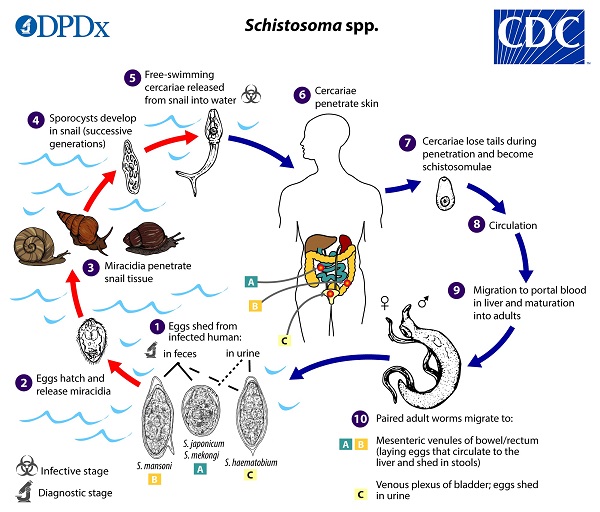Schistosoma mansoni - Life Cycle, Pathogenesis, Pathology, Host Immunity
Life Cycle of Schistosoma mansoni
The life cycle of Schistosoma mansoni is completed in the following hosts.
Definitive host: Man, rodents (South America), and baboons (Africa) are the definitive host.
Intermediate host: Freshwater snails of the genus Biomphalaria
man becomes infected with Schistosoma mansoni after coming in contact with water contaminated with cercaria – the infective stage
this cercaria penetrates the epidermis of the unbroken skin with the help of oral and ventral suckers
after losing its tail in the skin and another layer of glycocalyces, it becomes schistosomula
during development, schistosomula acquires:
* a double-lipid bilayered tegument that is highly resistant to host immune response
* host proteins, blood group antigens, and major histocompatibility complexes (MHCs) on its surface
the schistosomula then migrates to dermal veins through the skin and eventually to pulmonary capillaries over many days
after living in the host lung for a short while, the blood fluke reaches the portal veins in the liver through the systemic circulation
in the portal veins of the liver, they develop into adult worms
a Schistosoma mansoni male holding a Schistosoma mansoni female in the gynecophoral canal moves out of the liver against the blood flow to reach the venules that drain the large intestine (sigmoid-rectal area)
after mating, the fertilized eggs are excreted out in the feces
the pre-patent period is 4 weeks to 5 weeks
while these oviposited Schistosoma mansoni eggs are partially mature, by the time they are passed out through the stool, they each contain miracidium- a fully developed larvae
the stool upon gaining access to the water hatch to release free-swimming miracidium
miracidium has a lifespan of 2-3 weeks during which they infect must infect the intermediate host- freshwater snails of the genus Biomphalaria; otherwise, they will die
in the snail host, the miracidium undergo asexual reproduction through first and second-generation sporocysts but lacks redial stage in its asexual cycle
after the asexual cycle, the larvae transform into fork-tailed cercariae - a single miracidium can give rise to nearly 100,000 cercariae
these infectious cercariae escape from their snail host and can survive in freshwater for up to 48 hours
if these cercariae can irritate each another human skin or any susceptible mammal host, they will survive and the life cycle of Schistosoma mansoni is continued

Image: Schistosoma mansoni lifecycle (Source: CDC)
Pathogenesis, Pathology of Schistosoma mansoni
Similar to Schistosoma haematobium, Schistosoma mansoni also causes cercarial dermatitis.
During oviposition, the adult Schistosoma mansoni causes a clinical syndrome known as Katayama fever. This fever is caused when high worm load and egg antigen stimuli result in the immune-complex formation and may lead to serum sickness-like disease.
Although Katayama fever is not caused by granuloma, the egg-induced granuloma is the key pathological lesion in the intestinal wall or in rare cases- the liver.
These egg Schistosoma mansoni granulomas can be found in the wall of the distal parts of the colon and the rectum. In cases of chronic infection, the intestinal wall may become thickened with fibrosis with the occurrence of papillomatous growth along the entire colon.
Ectopic Schistosoma mansoni granulomas can be found in the liver, and lungs but rarely in the spinal cord.
Host Immunity of Schistosoma mansoni
One of the immunological characteristics of Schistosoma mansoni infection is concomitant immunity.
Concomitant immunity (CI) is the host’s immunity being able to develop an effective defense against larval stages of the parasite while it is unable to clear the persistent infection of adult parasites.
The protein composition of the Schistosoma mansoni egg induces a T-cell mediated mechanism which is responsible for larger granuloma development.